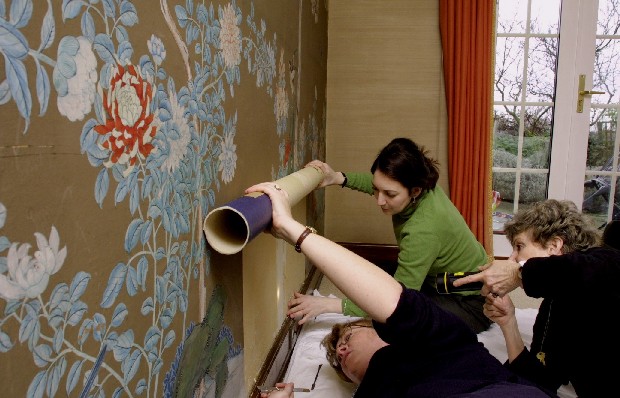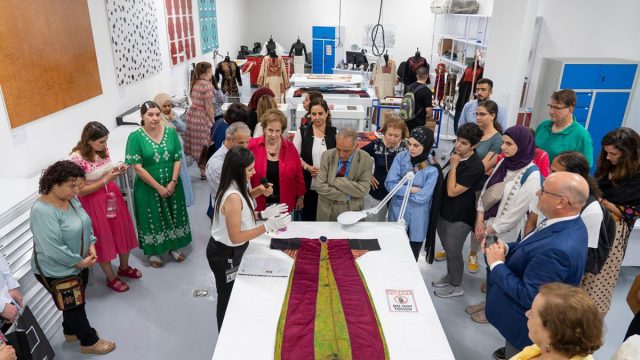Paper Conservators at the V&A are responsible for everything from minute portrait miniature paintings to enormous printed posters. Historic wallpapers also come under their remit, and the V&A has an extremely fine collection. As part of a series of posts on new displays for the British Galleries, Senior Paper Conservator, Susan Catcher explains the processes involved in conserving and mounting a panel of Chinese export wallpaper.

Removing Chinese export wallpaper from the walls of an historic interior © Victoria and Albert Museum, London
Chinese Export Wallpapers: Materials and Techniques
As a conservator, the understanding of the materials and techniques used in the manufacture of Chinese export wallpapers, combined with a good knowledge of Chinese and Japanese mounting techniques is crucial in developing an approach to their conservation.
Export wallpapers were created in China for the British market in the 18th century as a direct result of a growing fashion for imported porcelain, silk and lacquerware imported from China and Japan. The so-called Chinoiserie style was at its height from 1750 to 1765. In about 1754, William and John Linnell designed one of the earliest Chinoiserie interiors in Britain -a bedroom commissioned by the 4th Duke and Duchess of Beaumont for Badminton House in Gloucestershire. The most important piece of furniture made for the bedroom by the Linnels was the Bed, currently on display in the British Galleries.
The panels of Chinese wallpaper that will be displayed behind the Badminton bed are not original to Badminton House, but are of the right period and provide the context for the display of the bed itself in the galleries. “Flowering plants and Birds” was designed in Guangzou between 1725 and 1750, was originally installed at Eltham Lodge, Kent, and was acquired by the museum in 1914 as a series of ten panels. The wallpaper is hand painted in inks and watercolour and features flowering trees and brightly coloured birds, common motifs for export wallpapers from China. As was the practice for historic interiors, the wallpapers were originally lined with a paper and textile backing and then mounted on a wooden stretcher. This had the function of both providing a completely flat surface, and also allowing for the panels to be removed easily when the decorative scheme changed.
Many Chinese export wallpapers owe their structure to traditional Chinese scroll paintings. They are made up from several sheets of paper laminated together with a starch-based adhesive. For the most part, the papers tend to be Xuan (Senshi) paper, made from the bast fibres of the blue sandalwood tree, usually mixed with rice straw, although kozo and bamboo fibres are also found in some wallpapers. Traditionally, the support paper onto which the wallpaper design has been painted is prepared with a ground of inert white pigment bound in animal glue. Powdered alum is then dusted onto the surface, sometimes mixed with mica in order to improve the smoothness, opacity and uniformity of the paper support, and reducing the absorption of the ink or paint into the paper.
The outline of the design is drawing on the prepared sheet in black carbon ink. Flat areas of colour are added next using organic and mineral pigments bound in animal glue. Fine details and glazes are added last. Although, the majority of the design is hand painted, a number of other methods were sometimes used for texture or adding detail. Small printing blocks were often used, for example in areas of foliage, but also multiple brushes were employed for the depiction of blades of grass, and stencils, line block printing and decoupage (cut and pasted paper) were also commonly used.
Dating from as early as the 1720s, this particular panel is clearly an important example of early painted Chinese export wallpaper. However the panel arrived in the conservation studio in extremely fragile condition. As you can imagine, with historic wallpapers we often encounter some of the worst damage that can occur to works of art on paper. It is generally the easiest and cheapest aspect of interior decoration to replace, and therefore it is the least likely to survive intact. Early examples in good condition are comparatively rare. The Eltham wallpaper panels had been lined several times with poor quality western and Chinese papers and the original paper had become extremely brittle over the years, suffering extensive losses throughout its composition (as you can see in the image below). It is badly stained and discoloured, and it had long ago been removed from its original stretcher, so was rolled tightly for storage and kept this way for many years.
Conservation
In order to conserve such a large and fragile paper object, conservators need to have a significant understanding of the materials and techniques involved in its creation. This not only informs the method of treatment but can also enhance its art historical meaning.
In this case, conservation required the removal of all but the first and original lining by painstakingly removing the old and later paper and textile additions with a scalpel and tweezers. Removing linings from badly degraded wallpapers can be extraordinarily difficult, as the lining papers are often quite thick and sturdy, while the original paper is typically as thin as cigarette paper. In this case, the old linings had caused such problems for the wallpaper, that it was considered appropriate to remove them and reline the wallpaper with better quality materials. Time is of the essence in this treatment, since the wallpaper must remain damp while the old linings are removed (the pigments are tested extensively beforehand to ensure they are not soluble in water). For such a large piece of fragile paper, this requires working methodically within a limited time period and preferably working on colder days of the year, as wet paper inevitably attracts mould growth after a number of days. The whole procedure was carried out by a team of paper, books and paintings conservators working together full time over a period of ten days.

V&A Conservators removing old linings from the back of an 18th century wallpaper panel. © Victoria and Albert Museum, London
The original colour of a paper like this could never be truly recovered, nor would it be appropriate for us to do so. However, the tone and the brittle acidic nature of the paper can be improved by carefully placing sheets of water-saturated absorbent paper to the back of the wallpaper in order to remove the soluble acidity from the paper. Similarly, to individually fill the multitude of losses in this panel, and to inpaint (retouch) the missing areas would be both extremely time consuming and unethical given the fact that so much of the design is missing. However, we are able to lessen the impact by using a lining paper that is sympathetic in tone and character to the original. In this case, using yasha, a traditional Japanese dye obtained from cones of the Alder tree, was used to tone new xuan paper (See this blog post on Kuzaki-zome, the traditional Japanese practice of using plant extracts to dye paper). This tone is carefully selected to be close to the original paper, but also slightly lighter then the original paper. This method follows traditional Chinese scroll mounting practice. Although we often use the same or similar materials that were used by the artists who created these painted works, traditionally these wallpapers were lined with textiles and mounted on a stretcher, and this method has been proven to be very damaging to paper objects. For this reason, we prefer to follow the methods of Chinese and Japanese scroll mounting whereby the wallpaper is treated as if it were a painting, and lined with Chinese paper, then with stronger Japanese kozo paper. It is allowed to dry under tension on a traditional Japanese Karibari board for several months.
The fully conserved panel (below) will be on display behind the Badminton bed in the new rotation for the British Galleries this Autumn.

Flowering Plants and Birds. Wallpaper Panel c.1725-50, Guangzou. After Treatment. © Victoria and Albert Museum, London




My Chinese wallpaper has been water damage by a leak from the attic of my home. Please could you give me the name of a suitable restorer so that I can get a quote for the restoration to send it to my insurance. I live near Newbury in Berkshire and I am very anxious to get the restoration completed today. I shall look forward to hearing from you as soon as is possible. With my thanks Genevieve Mather
I have a load of Chinese wallpaper which was damaged by a water leak from the attic of my home. Please could you give me the name and contact details of a restorer who could give me a quote for my insurance company to have this paper restored and could carry out the work. I live near Newbury in West Berkshire. I shall look forward to hearing from you as soon as possible. Yours sincerely, Genevieve Mather
I need to restore a large Chinese wallpaper panel from the ’60 sh. The panel is very nicotine stained and should be cleaned. My idea is to clean this gentle with Hydrogen Peroxide. Would this be the right choice?
Hi, I would advise against this in the strongest possible terms. Hydrogen peroxide is a very aggressive reagent. It would bleach the nicotine stains in the short term but without carefully removing the resulting residue from the paper (caused by the oxidative effect of the peroxide), even in low concentrations, it will likely cause damage, and worse could potentially destroy what remains of your wallpaper. Please consider consulting a professional paper conservator for advice. Several specialists in wallpaper conservation can be found on the Institute of Conservation (ICON) website.